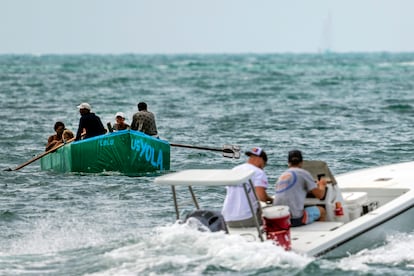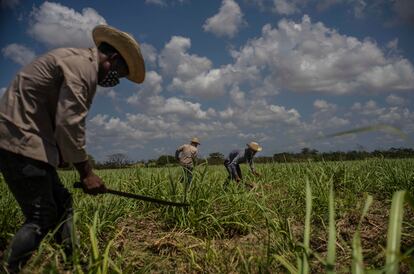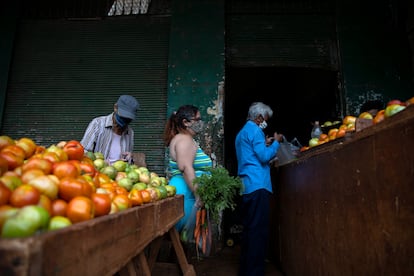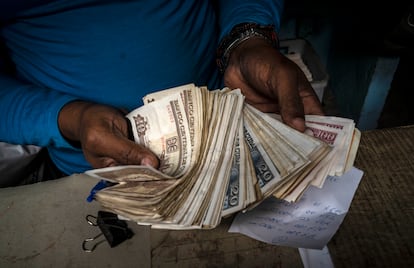The never-ending Cuban exodus
In just one year, 224,000 citizens –mostly young people – have left the island nation for the United States

Almost every day there’s a new number, a new tragedy, or a new and shocking story about escape from Cuba. The magnitude of the economic, social and political crisis that Cuba is experiencing is clearly reflected in the unprecedented exodus of its people. In October, US Coast Guard ships intercepted 1,100 boaters on the high seas, more than the number for all of 2021. According to US Customs and Border Protection, a daily average of 891 Cubans entered illegally from Mexico in September, for a total of 26,742 in that month alone. September 2022, the last month of the government’s fiscal year, was a record-breaking month for Cuban migration to the US – 224,607 Cubans arrived by land and another 10,000 tried to cross the Florida Straits, although only about 3,000 made landfall. Then there’s the uncounted numbers of Cubans who migrated through other countries. All in all, this outbound migration from Cuban accounted for 2% of the country’s inhabitants, and more than 4% of its working-age population. Economist Omar Everleny said: “It’s mostly young people who are leaving. Many are professionals or skilled laborers who have lost hope that things will improve.”
Everleny is among the many Cubans who have been warning about the alarming situation their nation is facing. It’s a real-life drama and serious demographic issue that threatens to compromise the future of the country’s 11.1 million citizens. In 2021, Cuba’s population decreased by 68,000, the fifth consecutive year of decline. The birth rate continues to fall, and the population is aging rapidly – 21% of Cubans are over 60 years old. This proportion is expected to climb to nearly 30% by 2030, according to official projections, and this is without accounting for the latest wave of emigration.
“Cuba is being drained of its young people. The country’s future has been dangerously mortgaged, and this can only lead to more political and social instability,” said economist Ricardo Torres, a Cuban who recently left his country for an academic position at the American University in Washington, DC. He says the severe crisis today was caused by “the structural problems that have afflicted the island for decades… and fixing them will require boldness, a more capable public sector, and many years of hard work.”

A teacher at a technical school in Havana said: “At every roll call there are fewer students. Their classmates tell me, ‘They’re gone – you don’t need to call their names anymore.’ My rough calculation is that at least 30% of my students have left in the last two years.” A waitress at a well-known family restaurant in Havana, says that there is a complete staff turnover every few months due to the exodus. To prove her point, she explained: “My WhatsApp contacts have almost no +53 [Cuba’s country code] numbers; they are all +1 [the US country code]. And I’m leaving next.”
A look around the island reveals an appalling landscape of endless queues, blackouts (which also affect the water supply), brutal food shortages, suffocating inflation, trash in the streets and impossible commutes because the garbage trucks and buses can’t get fuel, meager salaries, medicine shortages and deteriorating health services, and increasingly agitated public demonstrations. People sell everything they own because they can’t stand it anymore. Cubans freely talk about it all, which is something new in a country where not so long ago people were very cautious about criticizing their government.
“The government’s political capital is running out,” said Carlos García Pleyán, a well-known sociologist from Cuba. “The citizenry’s confidence in their government’s ability to straighten out the situation has vanished after so much vacillation and all the incoherent policies. There is little margin for error and their inept anti-inflationary measures have exhausted all hope. Economic and social inequality grows daily, resulting in greater political radicalization. Dialogue is getting more and more difficult, and anxiety about the future is mounting.”
As economists, Everleny and Torres have been studying the macroeconomic factors contributing to the most severe crisis in Cuba since the socialist system began waning in the 1990s. Most of the island’s economic indicators are negative, but the current annual sugar production is perhaps the most vivid example of the government’s failings. In the 1980s, annual sugar production averaged eight million tons. More than 150 sugar mills were operating back then, half of which were dismantled in the early 2000s. For the most recent harvest, only 36 mills were in operation and produced only 480,000 tons of sugar, the lowest amount in 100 years. This season, 23 sugar mills will attempt to produce 450,000 tons, which will be hard to achieve because only 41% of the sowing plan was completed in November, according to official sources.

Due to the extreme scarcity of foreign currency and very poor liquidity, the government’s ability to import goods and food has dropped by more than 50% compared to a decade ago. This has led to severe shortages, lines of desperate customers and rising black market prices. The government’s ill-conceived fiscal measures (“Tarea Ordenamiento”) to prop up the Cuban peso and restructure wages and pensions have only exacerbated inflation.
Government officials blame external factors for aggravating the crisis and say they cost the country more than $6 billion during in the first 14 months of the Biden administration. The current global economic downturn, the lingering aftereffects of the pandemic and the stepped-up US embargo are several of these external factors. But Ricardo Torres said: “Cuba’s main problem is that its economic model has not evolved, which prevents the country from exploiting its internal resources and becoming a viable player in the global economy.” Omar Everleny agrees and points out that the government’s plan to promote development of small and medium-sized private enterprises, approved in January 2021 after 10 years gathering dust on a shelf, still faces numerous obstacles, although 5,600 such enterprises have been authorized. “The private sector is our greatest resource, but change has been too slow in coming,” said Everleny. “To rebuild the economy, we need a decisive and radical transformation.”
Historian Alina Bárbara López says that this crisis is different because: “People have lost all hope. They realize that the government is incapable of making the changes the country needs for things to improve – not just economic changes, but also political ones. People can’t stand it any longer and they don’t see any future. It’s a humanitarian crisis because entire families are leaving, and most of them are valuable, enterprising young people.”
The talk on the street isn’t about macroeconomics, but about daily survival. A cardiologist in Cuba earns about $250 a month (6,000 pesos). The minimum wage is $88 a month and the average Cuban earns a little less than double that amount. Prices are astronomical in the markets, where the law of supply and demand reigns. But these are the only places to buy food because the state-run farms produce so little. At a market in the Havana neighborhood of Vedado, a pound (453 grams) of tomatoes costs $12; a pound of onions is $11; a pound of black beans is $5; and a pound of limes is $8. A kilo (2.2 pounds) of fatty pork costs over $33 and a single, smallish avocado is $2. Daily price increases have created a niche for resellers who position themselves near the market and offer a carton of eggs for $66, a 10-pound bag of chicken for $105, and liter of vegetable oil for $30.

When the government’s fiscal measures began in January 2021, the black market exchange rate was between 35 and 40 Cuban pesos to one US dollar (the official rate then was 24 to one). By August 2022, it had risen to 115 pesos. The current black market rate is 175 to one, although it has spiked as high as 200. “If you don’t have dollars, and most people don’t, you’re really screwed,” said a man on the street, who thinks that the blackouts are the worst problem right now. In many parts of the interior, people have suffered for months on end from power blackouts lasting 12 hours or longer due to the terrible state of the country’s power plants after years of neglect.
The stampede to leave Cuba often ends in tragedy. A recent collision between a US Coast Guard vessel and a boat that had come from the US to pick up migrants near the northwestern coast of Cuba caused at least five deaths, including a minor. The almost two dozen survivors plucked from the sea said that they were deliberately rammed by the Coast Guard, and called it “murder.”
Cuba says the US is to blame for such tragedies because it “encourages illegal emigration” with laws like the Cuban Adjustment Act of 1966, which allows Cuban natives or citizens to apply to become lawful permanent residents 366 days after arriving in the country, even if they entered illegally. Cuba also faults the US with failing to comply with a bilateral agreement to grant 20,000 visas to Cubans each year. While the Cuban government blames the long-running US embargo for almost all its ills, the US says the Cuban government’s inability to care for its citizens is the reason for the current migration explosion. In early November, Assistant Secretary for Consular Affairs Rena Bitter and US Citizenship and Immigration Services Director Ur Mendoza Jaddou traveled to Havana, the highest level visit to Cuba by US officials since Biden took office. At the end of the talks, the US announced full resumption of immigrant visa processing in early 2023 and the reestablishment of US consular services in Havana. On November 11, US sources announced that Cuba had just agreed to receive deportation flights of irregular Cuban immigrants held at the Mexican border, a game-changing development if implemented.

On November 3, the United Nations General Assembly voted on its annual resolution calling for an end to the United States-led embargo on Cuba. By a vote of 185 in favor to two against (Israel, United States), with two abstentions (Brazil, Ukraine), the UN adopted the resolution, just as it has for the last 30 years. Everything remains the same in this political standoff that has trapped Cubans on their island for 60 years.
Alina Bárbara is very critical of both governments, and has repeatedly called for an end to the embargo. “This year alone, more than 20,000 people leave every month and risk their lives crossing Central America as they head north from Nicaragua,” said Bárbara. “The Cuban government should realize that there’s a serious problem and they’re not going to get 20,000 visas a month [from the US].” The ones who are leaving are young, and have more money and skills, she says, and the only ones staying behind are those who have no way of getting out. “That’s all that we’ll have here,” she said. Bárbara also thinks that the government would be making a “serious mistake” if it views emigration as a useful escape valve, especially considering the massive protests on July 11, 2021 and the worsening living conditions that have turned Cuba into a pressure cooker for its people. “The people getting out now are not the same as those who left before to work and send money back to their families. These young people don’t want anything to do with Cuba, and they don’t have much family left here because everyone is leaving.”
Ulises Aquino is a Cuban singer and entrepreneur who recently posted on social media that more and more members of his musical theater company, La Ópera de la Calle, have been calling him to say goodbye. “Every one of these calls is a slap in the face. There have been many calls, too many…” said Aquino. And what’s worse, “They’re not leaving because of dreams about winning America’s Got Talent or The Voice. They just want to find work and live life. They want to be able to eat a simple meal without all the ordeals. And they want to dream in a place where nobody forbids them to dream, even if they never come true.” Aquino thinks that’s the big problem. “For many generations, [life in Cuba] hasn’t been anyone’s dream. It’s a paranoid existence for the young and a nightmare for the old.”
Carlos García Pleyán shares this sentiment. “People are wondering if the sacrifices are worth it when the promises of the Cuban Revolution – social justice and equity – can no longer be fulfilled.” How much damage did Donald Trump’s efforts to suffocate the Cuban economy cause? Plenty, but since Havana can’t do anything about that, most Cuba watchers wonder about the impacts of the slow pace of change on the widespread despair permeating the nation. The consensus is that the current crisis and massive exodus mean that staying the course is the only option that must be discarded. “To have any hope for a brighter future, this paralysis must end,” said Pleyán.
Tu suscripción se está usando en otro dispositivo
¿Quieres añadir otro usuario a tu suscripción?
Si continúas leyendo en este dispositivo, no se podrá leer en el otro.
FlechaTu suscripción se está usando en otro dispositivo y solo puedes acceder a EL PAÍS desde un dispositivo a la vez.
Si quieres compartir tu cuenta, cambia tu suscripción a la modalidad Premium, así podrás añadir otro usuario. Cada uno accederá con su propia cuenta de email, lo que os permitirá personalizar vuestra experiencia en EL PAÍS.
¿Tienes una suscripción de empresa? Accede aquí para contratar más cuentas.
En el caso de no saber quién está usando tu cuenta, te recomendamos cambiar tu contraseña aquí.
Si decides continuar compartiendo tu cuenta, este mensaje se mostrará en tu dispositivo y en el de la otra persona que está usando tu cuenta de forma indefinida, afectando a tu experiencia de lectura. Puedes consultar aquí los términos y condiciones de la suscripción digital.
More information
Archived In
Últimas noticias
Most viewed
- David King, chemist: ‘There are scientists studying how to cool the planet; nobody should stop these experiments from happening’
- Reinhard Genzel, Nobel laureate in physics: ‘One-minute videos will never give you the truth’
- Mexico completes its trade shift with the entry into force of tariffs on China and countries without trade agreements
- Oona Chaplin: ‘I told James Cameron that I was living in a treehouse and starting a permaculture project with a friend’
- Sinaloa Cartel war is taking its toll on Los Chapitos










































